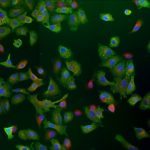Link to Pubmed [PMID] – 23063830
Vaccine 2012 Dec;30(51):7411-7
Dynamic studies of influenza virus infection in the live cells are limited because of the lack of appropriate methods for non-invasive detection of the viral components. Using the split-GFP strategy, we have recently developed and characterized an unimpaired recombinant influenza A virus encoding a tagged PB2 subunit of RNA-dependent RNA polymerase, which enabled continuous real-time visualization of the viral ribonucleoproteins (vRNPs) in living cells (Avilov, Moisy, Munier, Schraidt, Naffakh and Cusack [12]). Here, using this virus, we studied vRNP trafficking and interaction with Rab11 in the context of quasi-wild type infection. In agreement with recent reports, we observed that upon nuclear export, progeny vRNPs accumulate in the particles containing Rab11, a multifunctional protein involved in vesicle trafficking which resides at recycling endosomes. Fluorescence resonance energy transfer microscopy indicated a distance <10nm between PB2 and Rab11, suggesting that a direct interaction occurs. Single particle tracking analysis showed that most of the motions of vRNP-positive particles in infected cells are slow, while rapid directional motions intermittently occur. Analysis focused on these intermittent motions indicated that depolymerization of either microtubules or actin filaments moderately reduced their occurrence, while disruption of both cytoskeleton components in combination suppressed the rapid motions entirely. Thus, the split-GFP based virus enabled us to obtain a live-cell based confirmation for the model of vRNP trafficking which assumes accumulation of vRNP in recycling endosomes through a direct interaction of PB2 with Rab11, and subsequent transport across the cytoplasm involving microtubules and actin filaments.


